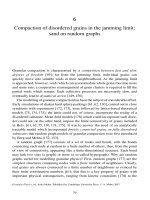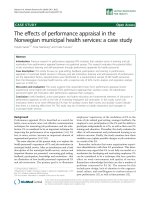Effects of retinoic acid on activation of rat microglia in the primary culture
Bạn đang xem bản rút gọn của tài liệu. Xem và tải ngay bản đầy đủ của tài liệu tại đây (1.76 MB, 119 trang )
EFFECT OF RETINOIC ACID ON ACTIVATION
OF RAT MICROGLIA IN THE PRIMARY
CULTURE
YAN JUN
NATIONAL UNIVERSITY OF SINGAPORE
2003
EFFECT OF RETINOIC ACID ON ACTIVATION
OF RAT MICROGLIA IN THE PRIMARY
CULTURE
YAN JUN
(M.Med.)
A THESIS SUBMITTED FOR THE DEGREE OF
MASTER OF SCIENCE
DEPARTMENT OF ANATOMY
NATIONAL UNIVERSITY OF SINGAPORE
SEPTEMBER 2003
i
Acknowledgements
________________________________________________________________________
Acknowledgements
I would like to express deepest appreciation and thanks to my supervisor, Dr. S
Thameem Dheen, Department of Anatomy, National University of Singapore, for his
immense patience and expert guidance throughout the course of the study.
I am greatly indebted to Professor Ling Eng Ang, Head, Department of Anatomy,
National University of Singapore, for his full support in providing me with the excellent
laboratory facilities and a fascinating academic environment, as well as for his valuable
suggestions to my project.
I am also thankful to Associate Professor Samuel Sam Wah Tay Department of
Anatomy, National University of Singapore, for the advice and constructive criticism.
I must acknowledge my gratitude to Mrs Yong Eng Siang, Miss. Teu Cheng
Hong Kate, Mrs Ng Geok Lan and Miss Margaret Sim for their technical assistance,
Mr Yick Tuck Yong for his assistance in computer work, Mr P. Gobalakrishnan for his
help in photomicrography, Mr Lim Beng Hock for looking after the experimental
animals, and Mrs Carolyne Wong, Miss Teo Li Ching Violet and Mrs Mohan Singh
for their secretarial assistance. I would like to thank all other staff members, my fellow
postgraduate students in the Department of Anatomy and National University of
Singapore for their support and encouragement.
Certainly, without the financial support from the National University of Singapore,
this work would not have been brought to a reality. This work was supported by a research
grant (NMRC/0680/2002 to Dr. S T Dheen).
Finally, I would like to thank my family and my friends for their unwavering
support through the years.
ii
Publications
________________________________________________________________________
PUBLICATIONS
International Refereed Journal:
Jun Yan, Eng-Ang Ling, Samuel SW Tay, S. Thameem Dheen, (2003) Retinoic acid
inhibits the expression of TNF-α and iNOS in the activated rat microglia.
(Glia 2003, In revision)
International Conference Paper:
J Yan, A.-J. Hao, E.-A. Ling, S.T. Dheen (2002) Response of microglia to β-amyloid in
primary microglia culture. Fifth European Meeting on Glial cell Function in Health and
Disease. 21-25, May, Rome, Italy. Glia 2002 May; (1 Suppl): S23
iii
Table of contents
_____________________________________________________________________
TABLE OF CONTENTS
Acknowledgements
Publications
Table of contents
Abbreviations
i
ii
iii
vi
ix
Summary
CHAPTER 1: Introduction
1
1.1. Origin of microglia
3
1.1.1. Origin from monocytes/macrophages
3
1.1.2. Origin from neuroectodermal cells
5
1.2. Types of microglia
6
1.3. Markers expressed by microglia
9
1.4. Factors that trigger microglial activation
10
1.5. Microglial activation in various neurodegenerative diseases
11
1.6. Alzheimer's disease and microglial activation
12
1.6.1. Microglial activation induced by Aβ peptide
12
1.6.2. Free radicals
13
1.6.3. Proinflammatory cytokines
14
1.6.4. Chemokines
16
1.6.5. Inhibitory cytokines
17
1.7. Cellular mechanisms of microglial activation
17
1.7.1. Signaling cascade in microglia following endotoxin exposure 17
1.7.2. Signaling pathways activated in microglia during aging and
Alzheimer's disease
1.8. Inhibitors of microglial activation
19
21
iv
Table of contents
_____________________________________________________________________
1.9. Retinoids
22
1.9.1. Expression pattern of RARs and RXRs in culyured cell lines
24
1.9.2. RARs and RXRs in adult mouse tissues
25
1.9.3. Expression pattern of RARs and RXRs in embryos
25
2.0. Aims of this study
26
CHAPTER 2: Materials and Methods
27
2.1. Animals and Microglia cultures
28
2.2.Treatment of cultures
31
2.3. Principles of Real-time PCR
31
2.3.1. DNA-binding dyes
32
2.3.2. Quantification of Real-time PCR
34
2.3.3. Threshold cycle
35
2.3.4. Selection of internal control and calibrator for 2-∆∆Ct method
35
2.3.5. Real-time PCR data analysis
35
2.4. Procedures of Real-time PCR
36
2.4.1. Extraction of total RNA
36
2.4.2. cDNA synthesis
37
2.4.3. Real-time PCR operation
37
2.4.4. Detection of PCR products
38
2.4.5. Analysis of Real-time PCR bands
39
2.5. Immunohistochemistry
39
2.5.1. Principles of immunohistochemistry
39
2.5.2. Procedures of immunohistochemistry
41
2.5.2.1. Fixation
41
v
Table of contents
_____________________________________________________________________
2.5.2.2. Procedure
42
CHAPTER 3: Results
43
CHAPTER 4: Discussion
47
CHAPTER 8: Conclusion
52
CHAPTER 9: Reference
57
FIGURES
80
vi
Abbreviations
_____________________________________________________________________
ABBREVIATIONS
Aβ – β-amyloid peptide
AD – Alzheimer’s disease
AIDS – Acquired immunodeficiency syndrome
APP – Amyloid precursor protein
AP-1 – Activator protein 1
Apo E – Apoliprotein E
BSA – Bovine serum albumin
B-SA – Biontin-streptavidin
CBP – cAMP response elements binding protein
cDNA – Complement DNA
CNS – Central nervous system
CREB – cAMP-response element binding protein
CSF – Cerebrospinal fluid
Ct – Threshold cycle
dNTP – deoxy nucleotide triphosphate
EDTA – Ethylene diamine tetra acetic acid
EC – Embryonal carcinoma
IHC – Immunohistochemistry
IκK – IκK kinase
IL-1 – Interleukine 1
IL-6 – Interleukine 6
IL-8 – Interleukine 8
IL-10 – Interleukine 10
INF-γ – Interferon γ
vii
Abbreviations
_____________________________________________________________________
iNOS – Inducible nitric oxide synthase
LPS – Lipopolysaccharides
MAPK – Mitogen activated protein kinase
MCP-1 – Monocyte Chemoattractant protein -1
mRNA – Messenger ribonucleic acid
MSH – Melanocyte-stimulating hormone
NSAIDs – Non-steroidal anti-inflammatory drugs
NF-κB – Neuclear factor κ B
NFTs – Neurofibrillary tangles
NLS – Neuclear localization signal
NO – nitric oxide
PAP – Peroxidase antiperoxidase
PBS – Phosphate buffered saline
PBS-TX – PBS Triton X-100
PCR – Polymerase chain reaction
PMA – Phorbol-12-myristate-13acetate
RA – Retinoic acid
RAGE – Receptor for glycated end products
RARE – Retinoic acid response elements
RARs – Retinoic acid receptors
RNA – Ribonucleic acid
ROS – Reactive oxygen species
RT-PCR – Reverse transcriptase-polymerase chain reaction
RXRE – Retinoid X response elements
RXRs – Retinoid X receptors
viii
Abbreviations
_____________________________________________________________________
SP – Senile plaques
TAE - Tris acetic acid EDTA
TGF-β – Transforming growth factor β
TGF- β1 – Transforming growth factor β isoform 1
TNF- α – Tumor necrosis factor α
ix
Summary
________________________________________________________________________
Microglia, the resident macrophages in the central nervous system (CNS), have
been shown to play an important role in the regulation of immune and inflammatory
activities as well as tissue remodeling in the CNS. In response to a variety of stimuli,
microglia undergo rapid proliferation, become hypertrophic and secrete a number of
proinflammatory cytokines, including tumor necrosis factor-α (TNF-α), interleukin-1β
(IL-1β), and cytotoxic molecules such as nitric oxide (NO) and reactive oxygen species.
Microglial activation has been reported in a variety of neurodegenerative diseases such as
Alzheimer’s disease, Parkinson’s disease and ischemic injury (Uno et al., 1997; Jellinger,
2000; Matsuoka et al., 2001). β-amyloid peptides (Aβ), HIV coat protein gp120, prion
protein-derived peptides have also been reported to be associated with various
neurodegenerative diseases via the neurotoxic factors released by microglia (Brown, 2001;
Qin et al., 2002; Gao et al., 2002). In culture, lipopolysacharide (LPS) and Aβ1-42 peptides
have been widely used for the activation of microglia which release neurotoxic and
proinflammatory mediators (Bronstein et al., 1995; Araki et al., 2001; Liu et al., 2002).
Although microglia play a beneficial role in neuronal cell viability and survival by
producing growth factors and removing potentially toxic cellular debris, several studies
have demonstrated that activated microglia can be deleterious to neurons through
excessive production of inflammatory mediators (Boje et al., 1992; Chao et al., 1992; Hao
et al., 2001). Hence, an understanding of the mechanisms that regulate microglial
activation is an important step to develop therapeutic strategies that prevent the
neurodegenerative diseases.
Several lines of evidence showed that retinoic acid (RA) exerts an antiinflammatory effect and attenuates the production of inflammatory mediators such as
TNF-α and iNOS in various cell types of peripheral tissues besides its crucial role in the
x
Summary
________________________________________________________________________
regulation of cell proliferation and differentiation (Mehta et al., 1994; Datta et al., 2001).
It is well known that RA modulates the target cell activity by binding to one of its two
nuclear receptors: retinoic acid receptors (RAR- α, β, γ) and retinoid X receptors (RXRα, β, γ. RAR or RXR may modulate gene transcription by directly binding to promoters
containing a retinoic acids receptor element (RARE) or via antagonistic cross-coupling of
transcription factors such as NF-κB (Xu et al., 1997). Recent studies have demonstrated
that RA receptors regulate inflammation in different cell types (Motomura et al., 2001;
Grummer et al, 2000). In addition, expression of RARβ was detected in the rodent brain
(Ree et al., 1992). In view of these observations, it is hypothesized that RA may modulate
the inflammatory response of microglia in primary cultures. Hence, we have investigated
the effects of RA on microglial activation and their secretions of inflammatory cytokines
as well as NO in primary cultures using immunohistochemistry and Real Time PCR.
Exposure of primary cultures of rat microglial cells to Aβ or LPS stimulated the mRNA
expression levels of TNF-α and iNOS significantly. RA decreased both TNF-α and iNOS
mRNA expression levels in microglia exposed to Aβ or LPS in a dose-dependent manner
(0.1-10µM). The anti-inflammatory effects of RA were correlated with the enhancement
of the retinoic acid receptor-β (RAR-β), and transforming growth factor-β1 (TGF-β1)
expressions as well as the inhibition of NF-κB translocation. These results suggest that
RA may inhibit the neurotoxic effect of activated microglia by suppressing their secretion
of proinflammatory cytokines and NO.
1
Chapter 1:Introduction
_____________________________________________________________________
CHAPTER 1
INTRODUCTION
2
Chapter 1: Introduction
_____________________________________________________________________
The central nervous system (CNS) contains a unique population of resident
macrophages termed microglia, representing approximately 5-12% of all glia found in
the brain. These cells play a prominent role in infectious, traumatic, inflammatory,
ischemic and degenerative CNS processes. During their life cycle, microglia display
considerable phenotypic heterogeneity, i.e. they may be ameboid, ramified or reactive,
the latter form being found in pathological conditions. Ameboid microglia are
abundant in the developing brain and phenotyically similar to reactive microglia with a
large spherical cell body and short processes. During postnatal stages of development,
the ameboid microglia transform into ramified microglia with several long processes.
Upon activation by inflammatory stimuli, the ramified microglia undergo a series of
morphological and functional changes in order to mobilize the cellular and molecular
defense system of the CNS. The reactive or activated microglia, which appear as fullblown phagocytes, express various cytokines and growth factors in order to respond to
neural injury in pathological conditions. Although del Rio-Hortega (1932) provided a
complete framework for defining the microglia, many questions of this cell type
remain unknown. An example is the origin of microglial precursors. At least there are
two hypothesizes, one stating that microglial cells are of mesodermal origin; the other
proposing that microglial cells originate from neuroepithelial cells. The former
statement is sustained by a large proportion of authors, who believe that microglia
derive either from monocytes that leave the blood stream and colonize the nervous
parenchyma, or from primitive (or stem) hemopoietic cells that differentiate as
microglial cells within the CNS.
3
Chapter 1: Introduction
_____________________________________________________________________
1.1. Origin of microglia
1.1.1. Origin from monocytes/macrophages
Microglial cells and cells of monocytic lineage share several features, such as
the presence of particular enzymes, the nucleoside diphosphatase, non-specific esterase
and acid phosphatase (Ling et al., 1982; Fujimoto et al., 1989; Castellano et al., 1991).
Microglial and monocytic cells contain large amounts of vault particles (Chugani et al.,
1991) and are labeled by several types of lectins (Hutchins et al., 1990; Acarin et al.,
1994). Moreover, antibodies that recognize both microglia and monocytic cells have
been developed in a number of species, such as fish (Dowding et al., 1991),
amphibians (Goodbrand and Gaze, 1991), birds (Jeurissen et al., 1988; Cuadros et al.,
1992), rodents (Imamura et al., 1990; Gehrmann and Kreutzberg, 1991; Perry and
Gordon, 1991; Flaris et al., 1993) and humans (Penfold et al., 1991; Paulus et al.,
1992). These findings, together with the phagocytic properties of microglial cells,
suggest that microglia are related to monocytic cells and belong to the mononuclear
phagocytic system.
Ling and coworkers (1979; 1980) in their experiment found the carbon-labeled
monocytes injected into the blood stream of newborn rats in the ameboid and ramified
microglia and hence they concluded that microglia originated from monocytes which
enter the nervous parenchyma from the blood stream.
Various
studies
support
the
idea
that
microglial
cells
are
of
monocyte/macrophage lineage. Cells with morphological features of microglia and
with a pattern of membrane potentials characteristic of microglia develop from
monocytes or non-nervous tissue macrophages which are cultured on an astrocyte
monolayer (Schmidtmayer et al., 1994; Sievers et al., 1994). At present, it is not
known whether all cells of the macrophage/monocyte lineage can produce microglia
4
Chapter 1: Introduction
_____________________________________________________________________
cells, or whether this ability is limited to a special subset of such cells. Giulian et al.
(1995) found that mononuclear phagocytes isolated from the brain of newborn rats
gave rise to cells with particular morphological features which did not appear in
cultured mononuclear phagocytes from non-nervous sources; these authors concluded
that microglial precursors are unique class of cell different from precursors of other
types of mononuclear phagocytes. In this connection, it was found that a subpopulation
of bone marrow-derived cells showed the same ion channel pattern as microglial cells,
suggesting that the bone marrow contains precursors that are committed to produce
microglia and that they are different from the precursors which produce macrophages
for other body regions (Banati et al., 1991).
However, macrophages/microglial cells appear within the CNS before it is
vascularized (Ashwell, 1991; Sorokin et al., 1992; Cuadros et al., 1993; Wang et al.,
1996) and before monocytes are produced in hemopoietic tissues (Sorokin et al., 1992;
Naito et al., 1996). Therefore, it has been suggested that not all microglial cells can
originate from circulating monocytes during development. Another possibility is that
some or all microglial cells derive from undifferentiated hemopoietic cells that
colonize the developing CNS independently of its vascularization (Hurley and Streit,
1996). In this regard Alliot et al. (1991) noted that hemopoietic cells that can
differentiate into microglial cells are present in the bone marrow and in the nervous
parenchyma of both adult and developing CNS of mice. The presence of macrophages
of hemopoietic origin within the early nervous parenchyma has been established using
quail–chick embryo chimeras (Cuadros et al., 1993). Although it is possible that these
embryonic macrophages give rise to the population of microglial cells in the adult, the
connection between them and microglial cells has not been conclusively established. In
fact, embryonic macrophages might also leave the CNS or degenerate after fulfilling
5
Chapter 1: Introduction
_____________________________________________________________________
their functions during development, and therefore they would not be microglial
precursors.
1.1.2. Origin from neuroectodermal cells
Several authors have sustained that at least some microglial cells are of
neuroectodermal lineage. Autoradiographic analyses of the genesis of microglia within
the mouse hippocampus showed that microglial cells seemed to derive from glioblasts
that also produce astrocytes; this conclusion was based on a presumed continuous
morphological transition from proliferating glioblasts to resting microglia (Kitamura et
al., 1984). The finding of microglial cells within the matrix cell layer during
development has been considered as an indication of the neuroepithelial origin of
microglia (Hutchins et al., 1990). However, the microglial cells within the
neuroepithelium may also be cells that are traversing the neuroepithelial layer after
entering the nervous parenchyma from the ventricle (Cuadros et al., 1994).
It was found that monoclonal antibodies against the protein lipocortin-1 label
both a fraction of neuroepithelial cells and microglial cells in the developing rat brain,
suggesting that microglial cells originate within the neuroepithelium (Fedoroff, 1995).
In addition, some of the antibodies that recognize microglial cells also label a
proportion of cells of neuroectodermal origin (Dickson and Mattiace, 1989; McKanna,
1993; Navascues et al., 1994; Wolswijk, 1995). Although these observations appear to
support the idea that microglial cells are of neuroectodermal lineage, it should be
recalled that sharing some antigenic markers does not mean that the two cell types also
share the same origin.
It has been shown that macrophage-like cells and/or microglia are produced in
cultures of embryonic neuroepithelium (Hao et al., 1991; Richardson et al., 1993;
Papavasiliou et al., 1996), suggesting that microglial cells may derive from embryonic
6
Chapter 1: Introduction
_____________________________________________________________________
neuroepithelial cells. Moreover, macrophage/microglial cells were produced in mouse
neuroepithelial cell cultures which are free of potential microglial precursors of
mesenchymal origin after selective elimination of cells bearing the Mac-1 antigen,
present in macrophages and microglial cells (Hao et al., 1991). However, the
macrophage-like cells produced in these cultures might derive from Mac-1 negative cells which had previously invaded the developing CNS. In this connection Alliot et al.
(1991) inferred that microglial cells may derive from cells in the nervous parenchyma
which have not yet acquired the Mac-1 epitope.
1.2. Types of Microglia
Microglia constitute a significant proportion of the entire population of cells in
the adult mammalian CNS (Lawson et al., 1990; McKanna 1993). These cells are
found throughout the adult CNS parenchyma and are usually process bearing, thus the
term "ramified" microglia (Fig 1.1). They are morphologically quite distinctive, having
a relatively small cell body and displaying several fine irregular processes with
numerous short branches and spiny-like projections. The number of primary processes
and their complexity is considerably variable and to some extent region or location
specific (Lawson et al., 1990). They are also notably distinguishable from other CNS
cells by a particularly heterochromatic nucleus. The various adult parenchymal cells
may also be referred to as "quiescent" or "resting" microglia, distinguishing them from
others that arise in pathological states. The latter terms appropriately reflect the fact
that these cells are highly downregulated in the expression of antigenic markers and
functional indicators associated with macrophages (Thomas 1992; Streit et al., 1988).
In the developing CNS, microglia appear “round”, “amoeboid”, and
“pseudopod”. In comparison to the adult ramified microglia, these cells are more like
7
Chapter 1: Introduction
_____________________________________________________________________
the classic macrophages as seen in other tissues. They express a wide array of
antigenic markers in common with other mononuclear phagocyte populations. It has
been suggested that this macrophages-like microglia type is principally involved in the
removal of cellular debris generated by cell death of neurons, macroglia, and/or
neuroepithelial cells in the developing CNS (Ashwell 1990; Ferrer et al., 1990).
Fig 1.1. Microglia classics. From left to right, transformation of resting microglia into
activated cells. (Adapted from Kreutzberg 1996 )
The resting or quiescent microglia of the adult appear to be exquisitely
sensitive to pathologic conditions and may become an "activated" microglia cell. This
involves both a morphologic and functional transformation. The delicate ramified
appearance begins to withdraw, the cell body enlarges, and cells may reenter the cell
cycle to undergo mitotic division. There is a remarkable upregulation of expression of
immune-related and other antigenic macrophage markers. The cell becomes migratory
and may ultimately become a full-blown macrophage-like phagocyte resembling the
8
Chapter 1: Introduction
_____________________________________________________________________
ameoeboid class of microglia (Moore and Thomas 1996; McGeer et al., 1993;
Gehrmann et al., 1995).
Microglia are highly mutable cells that can take on a wide variety of
phenotypes in vivo as discussed above. They display similar diversity in cell culture.
Their distinctive morphologies are described as visualized by phase-contrast optics
(Dobrenis, 1998):
1. Type 1 - This type is a relatively large flattened cell with a circular to oval
profile. It has been referred to as macrophages, "pancake-shaped" and
amoeboid. This is one of the major microglial types seen in the first few days in
vitro, though they may also persist for months in varying abundance depending
on the specifics of the preparation. The cell may extend several extremely fine
short spine-like projections or a extremely long thicker single process ending in
a large fan-like terminal.
2. Type-2 is a cell with a long, almost tubular or rod-shaped appearance. This is
phase dark or gray and shows variable degrees of flattening. Either end may
terminate in a flattened membranous expansion or tuft of spinous projections.
3. Third type is a medium to large round cell with a vacuolated appearance.
4. Type 4 is similar to the previous type, but this type also bears short
lamellipodia, giving it an uneven circular profile at low magnification. At
higher magnificantion these furly structures can clearly be seen, resembling
paddles and often arising in several spots on the cell.
5. Type 5 is very small (<10µm in diameter) round cell with one or two very fine
short processes.
6. Type-6 is relatively small; rather dark, irregular cell with two or three short
thick, pseudopodium-like processes bearing lamillipodial-like terminals.
9
Chapter 1: Introduction
_____________________________________________________________________
7. Type 7 has more of a star-shaped appearance with light gray to bright cell body
and many short, somewhat tapering processes.
8. Finally, Type 8 cell resembles a ramified microglia cells. This is several fineto medium-caliber processes of greater length than those of type 6 and 7, which
may display short branches or spines. The cell body is often relatively small,
but depending on how the process arises, may appear to be large.
1.3. Markers expressed by microglia
Microglia express a wide range of surface and cytoplasmic markers that make
them distinct. Both rat and human microglia were found to express the complement
receptor C3b, which is involved in the binding of complement opsonised particles.
Adult human and neonatal rat microglia expressed macrophage cytoplasmic antigens
(EBM-11 and ED 1, antibodies respectively) (William et al., 1992). Complement
receptor C3b was also found to be expressed intensely in amoeboid microglia in the
early postnatal rat although the staining intensity diminished in the late postnatal
period as the cell becomes ramified (Ling et al., 1990). Human microglia express
MHC (major histocompatibility complex) class I antigens (Hayes et al., 1987). This is
in contrast with rat microglias, which express little or no MHC II constitutely, although
expression can be induced by treatment with interferon-γ (IFN-γ) (Woodroofe et al.,
1989). Non-specific esterase is often used as markers for monocytes and it is also
expressed by amoeboid microglia but not by adult ramified microglia (Hayes et al.,
1988; Thomas, 1992). Other commonly used markers for both the ramified and the
amoeboid microglia are the plant lectins, B4 isolectin and agglutin-120. These lectins
bind to the D-galactose in microglia and, within the brain parenchyma, do not label
neurons, astrocytes, or oligodentrocytes (Thomas, 1992).
10
Chapter 1: Introduction
_____________________________________________________________________
1.4. Factors that trigger microglial activation
Viral envelopes, bacterial cell wall components, and other infectious agents
(prion protein) cause macrophage/microglial activation (Heppner et al., 2001).
Lipopolysaccharides (LPS) of gram-negative bacteria serve as standard agents in
mimicking infections.
CNS injury liberates signals that instruct microglial transformation. Trauma
signals can be subtle and affect microglia in the vicinity of neuronal somata while the
primary insult is set farther away (Streit 2000). Microglial activation might be initiated
or modified by molecules commonly released in neurotransmission (Fields and
Stevens, 2000; Honda et al., 2001). CNS injury may release factors (including
cytokines) that are bound to the extracellular matrix in a functionally silent pool, but
carry latent microglia-activating signal character.
Disease-related production, processing, and aggregation of proteins, such as
amyloid-β (Aβ) in Alzheimer disease (AD), can stimulate microglia, including its
release properties. In conjunction with other stimuli, aggregates seem to irritate
microglial cells chronically as they concentrate around senile plaque (SP), the major
pathological lesion of AD. Clusters of activated microglia then produce factors (such
as Interleukin-1 or IL-1, Tumor Necrosis Factor-α or TNF-α) that can drive neurotoxic
cascades which in turn recruit more microglia.
Microglial activation is basically a beneficial, physiologically approved
reaction aiming at protection and restoration of endangered CNS structures and
functions. Only excessive or sustained stimulation will lead to pathological changes in
the CNS. Many products released by the microglia, such as reactive nitrogen and
oxygen intermediates, are toxic to neurons (Zielasek and Hartung, 1996). Indeed, many
studies also reveal the toxic and cell death-inducing potential of cytokine, such as
11
Chapter 1: Introduction
_____________________________________________________________________
TNF-α, for neurons and oligodendrocytes. The microglial mediators may induce
secondary reactions in endogenous or infiltrated cells, which are harmful for neuronal
structures. In addition, microglia can trigger or increase the release of potentially toxic
agents and neuromodulatory compounds, including glutamate from astrocytes.
Cytokines and chemokines of microglial origin assist in the process of leukocyte
invasion via enhanced expression of endothelial adhesion molecules and chemotactic
guidance. Microglia also stimulate lymphocytes by representing antigen in conjunction
with costimulatory signals and the release of cytokines (Dasguputa et al., 2002).
Certain (microglial) cytokines appear to have the most critical role in
neuropathological scenarios. Prime candidates are tumor necrosis factor-α (TNF-α)
and nitric oxide (NO) (Rothwell and Luheshi 1996; Rothwell 1997).
1.5. Microglial activation in various neurodegenerative diseases
It is well known that microglia play a key role in mediating inflammatory
processes, which are associated with various neurodegenerative diseases. Growing
evidence indicates that amyloid deposition and microglial activation participate in
inflammatory reactions in the Alzheimer’s disease brain. In AIDS dementia patients,
progressive neurodegeneration is the consequence of activation of microglia that are
infected with HIV. In Huntington’s disease, overproduction of complements by
activated microglia may cause neurodegenration (Singhrao et al., 1999). Nitric oxide
(NO) produced by microglia plays an important role in the death of dopaminergic
neurons in MPTP (a neurotoxin used to induce Parkinson's disease) model of
Parkinson’s disease (Dehmer et al., 2000). In multiple sclerosis, the rapid destruction
of oligodendrocytes by necrosis is followed by delayed destruction by apoptosis with
an activated microglia/macrophages invasion (Jamin et al., 2001). Microglial
12
Chapter 1: Introduction
_____________________________________________________________________
activation also play important roles in the pathogenesis of sponggiform
encephalopathies (Prion disease) (Rezaie and Lantos, 2001).
1.6. Alzheimer’s disease and microglial activation
Alzheimer's disease (AD) is the most common neurodegenerative disorder of
the elderly, and it is characterized clinically by relentlessly progressive memory loss,
as well as other cognitive impairments. The neuropathological hallmarks of AD
include abundant deposits of Amyloid-beta (Aβ) fibrils in senile plaques, massive
accumulations of abnormal tau filaments (one type of microtuble-associated proteins)
in neurofibrillary tangles (NFTs), and extensive neuronal degeneration associated with
profuse reactive microglia (Clark et al., 2000). Apart from the SPs and NFTs, AD
brains also exhibit a number of additional nondiagnostic pathological abnormalities,
including a profound loss of synapses, massive neuronal degeneration, extensive
gliosis, microglial proliferation/activation, and evidence of an unusual inflammatory
process (Clark et al., 2000).
1.6.1. Microglial activation induced by Aβ protein
Amyloid-β (Aβ) is a 39- to 42-amino acid cleavage product of a
transmembrane glycoprotein, amyloid precursor protein (APP). Synthetic peptide
homologous to Aβ and its fragments had been utilized to investigate their role in AD
(Glenner and Wong, 1984). Aβ peptides have been shown to be amyloidogenic under
experimental conditions and numerous studies have been performed to clarify the
mechanisms of glial activation in vitro induced by exposure to these molecules.
Synthetic form of full-length human Aβ promotes neuronal death in the presence of
microglia (Meda et al., 1995b). In vitro studies have been performed to identify
specific regions of the Aβ peptide required for eliciting neurotoxicity and microglial
activation. In this context, several reports have suggested that the amino-terminus of
13
Chapter 1: Introduction
_____________________________________________________________________
Aβ1-42 contains domains critical for cellular binding and biologic effects such as
complement activation (Van Muiswinkel et al., 1999). Studies on the structure and
function of Aβ1-42 have identified a cluster of basic amino acids HHQK (Aβ13-16),
which are assumed to act as a plaque-anchoring site for microglia and necessary for
microglial activation (Giulian et al., 1998). Extensive investigations on the
cyototoxicity of different regions of Aβ1-42 indicate that fragment of Aβ25-35 is
biologically active on neuronal and glial cells (Meda et al., 1995b; Pike et al., 1993;
Yankner et al., 1990). This fragment has been widely used as it lacks the critical Nterminal site for complement activation and thus allows a selective focus on noncomplement mechanisms such as cytokine signaling.
1.6.2. Free radicals
Reactive oxygen species (ROS) including superoxide anions, hydroxy radicals,
and hydrogen peroxide are generally hazardous to a host of intracellular functions in
target cells, e.g. membrane properties, energy production and cytoskeletal stability,
particularly to myelin and its forming cells, oligodendrocytes. LPS and phorbol-12myristate-13acetate (PMA) are stimulators of ROS production from cultured microglia.
Nitriogen oxides such as nitric oxide (NO) are highly reactive free radicals, of which
nitrite peroxide is the strongest reactive oxygen specie. NO has been implicated in
neurotoxicity. However, the mechanisms of NO-induced neurotoxicity are still unclear,
but have been proposed to include the following (1) activation of poly (ADP ribose)
polymerase followed by NAD and ATP depletion (Zhang et al., 1994), (2) induction of
apoptosis by poorly defined mechanisms (Uehara et al., 1999), and (3) glutamate
release (Trabace et al., 2000) and excitotoxicity (Hewett et al., 1994; Leist et al., 1997)
and inhibition of mitochodrial respiration (Brown, 1999). LPS and β-amyloid are
known to stimulat NO production from microglia. In the presence of Interferon-γ (INF-









